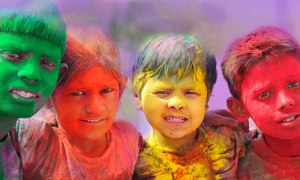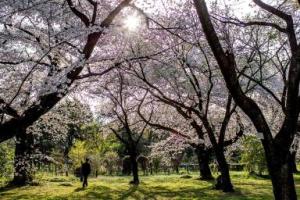The start of the spring season represents a new beginning as the seasons change from the dead of winter to the colorful and lively spring months. The changing season not only marks the physical change of nature, but also the changes which occur within individuals, including a renewed desire for growth and change. Let’s see how 4 countries far away from us celebrate the arrival of spring.
India-Holi
India celebrates spring through the festival of Holi. Also known as the festival of colors,  Holi is an ancient Hindu festival celebrated annually as the spring equinox approaches. Holi “marks the end of the winter gloom and rejoices in the bloom of the spring time.” The festival holds great spiritual, social and mythological significance. The day after the first full moon of March marks the start of Holi. On the eve of the festival, people light bonfires to celebrate the triumph of good over evil. Ash from the bonfire is considered sacred with many applying the ashes to their foreheads as further protection from evil. The day of Holi, stores and businesses shut down, and friends, neighbors and strangers come together in a collective euphoria. Indians old and young celebrate by throwing colored water and powder on each other.
Holi is an ancient Hindu festival celebrated annually as the spring equinox approaches. Holi “marks the end of the winter gloom and rejoices in the bloom of the spring time.” The festival holds great spiritual, social and mythological significance. The day after the first full moon of March marks the start of Holi. On the eve of the festival, people light bonfires to celebrate the triumph of good over evil. Ash from the bonfire is considered sacred with many applying the ashes to their foreheads as further protection from evil. The day of Holi, stores and businesses shut down, and friends, neighbors and strangers come together in a collective euphoria. Indians old and young celebrate by throwing colored water and powder on each other.
China-Quindming Festival
China’s spring begins with the Qingming Festival. The festival begins by the 104th day after the Winter Solstice. People take this time to visit the graves of their ancestors. They will clean the graves, offer food and drink to their deceased relatives and spend time together. Families come together by celebrating, singing and cleaning throughout the festival. Qingming also marks the beginning of spring plowing and the start of the harvest for the spring season.
Iran- Nowruz
Nowruz is the traditional Iranian festival which marks the beginning of the Spring season during the vernal equinox. The word itself, in Persian, translates to mean “New Day.” Celebrations include a traditional spring cleaning and the Wednesday Suri, the Iranian festival of fire in which participants jump over bonfires to symbolize light (the good) winning over darkness (the bad). Modern Iranians celebrate New Year for 13 days. The first few days are spent visiting older members of the family other relatives and friends where gifts are exchanged and sweets and feasts are consumed. On the last day, the 13th day of the first month, people leave their homes to go to the parks or rural areas to spend a day in nature.
Japan-hanami
Hanami is an important Japanese custom and is held all over Japan in spring. Hanami literally means viewing flowers, but it generally indicates cherry blossom viewing. This  tradition, ancient more than a millennium, is still very much felt in Japan . The spectacle of sakura blooming occupies much of the spring and can be seen from the beginning of April until mid-May. To the Japanese, the cherry blossoms sudden arrival combined with their tremendous beauty and fleeting nature, symbolizes the transitional nature of life. Nowadays the Japanese celebrate cherry blossoms with picnics and parties under the plentiful trees (hanami). Gatherings are full of food, from Japanese junk food to barbeque to pickled cherry blossom leaves!
tradition, ancient more than a millennium, is still very much felt in Japan . The spectacle of sakura blooming occupies much of the spring and can be seen from the beginning of April until mid-May. To the Japanese, the cherry blossoms sudden arrival combined with their tremendous beauty and fleeting nature, symbolizes the transitional nature of life. Nowadays the Japanese celebrate cherry blossoms with picnics and parties under the plentiful trees (hanami). Gatherings are full of food, from Japanese junk food to barbeque to pickled cherry blossom leaves!
Read more about other spring festival at these links:
https://www.tcsworldtravel.com/blog/spring-festivals-around-the-world
http://www.independenttraveler.com/blog/index.php/2015/03/19/5-spring-festivals-around-the-world/
